- Homepage
- News and Features
- Meet the team preparing the course for the BMW PGA Championship
Meet the team preparing the course for the BMW PGA Championship
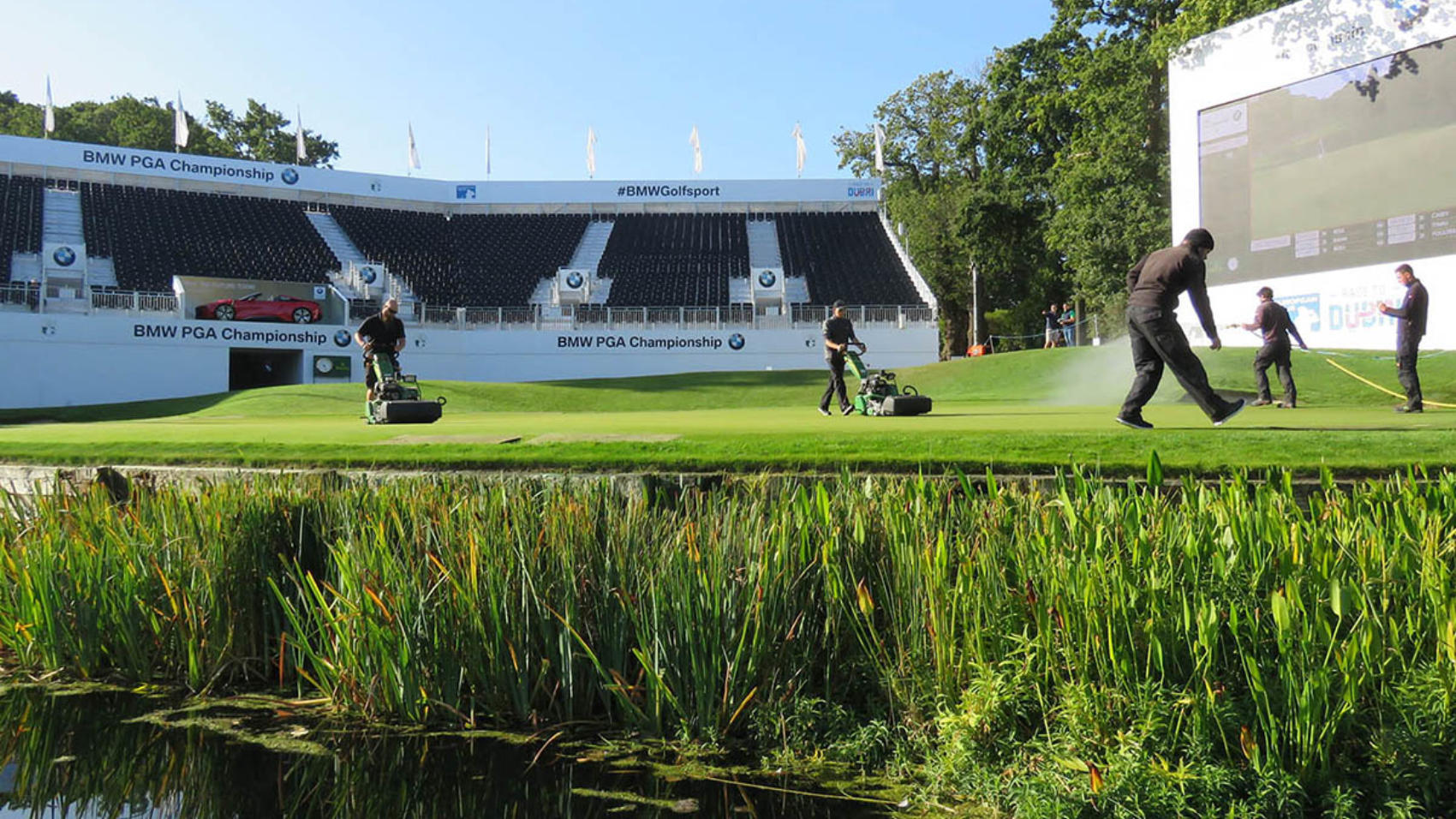
The BMW PGA Championship has shifted from its regular May timing to this weekend. How will that impact the course and what does it mean for the greenkeepers tasked with preparing it for the European Tour’s flagship event?
Peter Moore is head greenkeeper of the West Course at Wentworth and he spoke to us about how the shift in dates will mean the golfers face a very different challenge this week.
BIGGA: Usually the BMW PGA is a distant memory by this point in the year. Just how different is hosting the event in September, compared to May?
Peter: There’s a couple of weather differences. Historically in May we found that the springs would either be really cold and dry or they’d be warm and wet, which isn’t ideal for a tournament. It would always come good in the end, but there’s always that little doubt in your mind.
This year we’ve had a full summer to prepare. The course hasn’t had the stress of the tournament in May so it’s come through the summer months a lot healthier and we’re in a much stronger position than we ever have been going into an event.
The only downside to having the event this side of the year is it’s starting to go cold in the evenings. Leaves are starting to turn, so if the wind picks up we may have problems with debris, particularly on the greens surfaces.
The dreaded worm casts on fairways have caused us a few problems over the last few weeks. It’s an additional part of the labour that we’ve put in, to switch the fairways before we mow them so we’re getting the best, most efficient cut and we’re not ruining the mower reels every time we go out.
BIGGA: Earthworm casting isn’t a glamorous subject but it’s an important one because there isn’t much you can do to prevent them at the moment, other than clear them away, is there?
Peter: We’re just using switches to clear them off in the morning. Long-term we’ve started a programme of topdressing on fairways and we’re looking into products to try and increase the acidity of the soil to try and deter them. If we’re going to have a September tournament each year, we can’t just accept they’re there, so we’re looking at other options to try and deter them from coming to the surface this time of the year. At the moment we’re fortunate that it’s very dry and they’re not really bad.
BIGGA: Do you communicate with the players to explain why they may notice things like that on the course?
Peter: We speak to the European Tour and they pass the message on. If they need to create a local rule or speak to the players about it then they will.
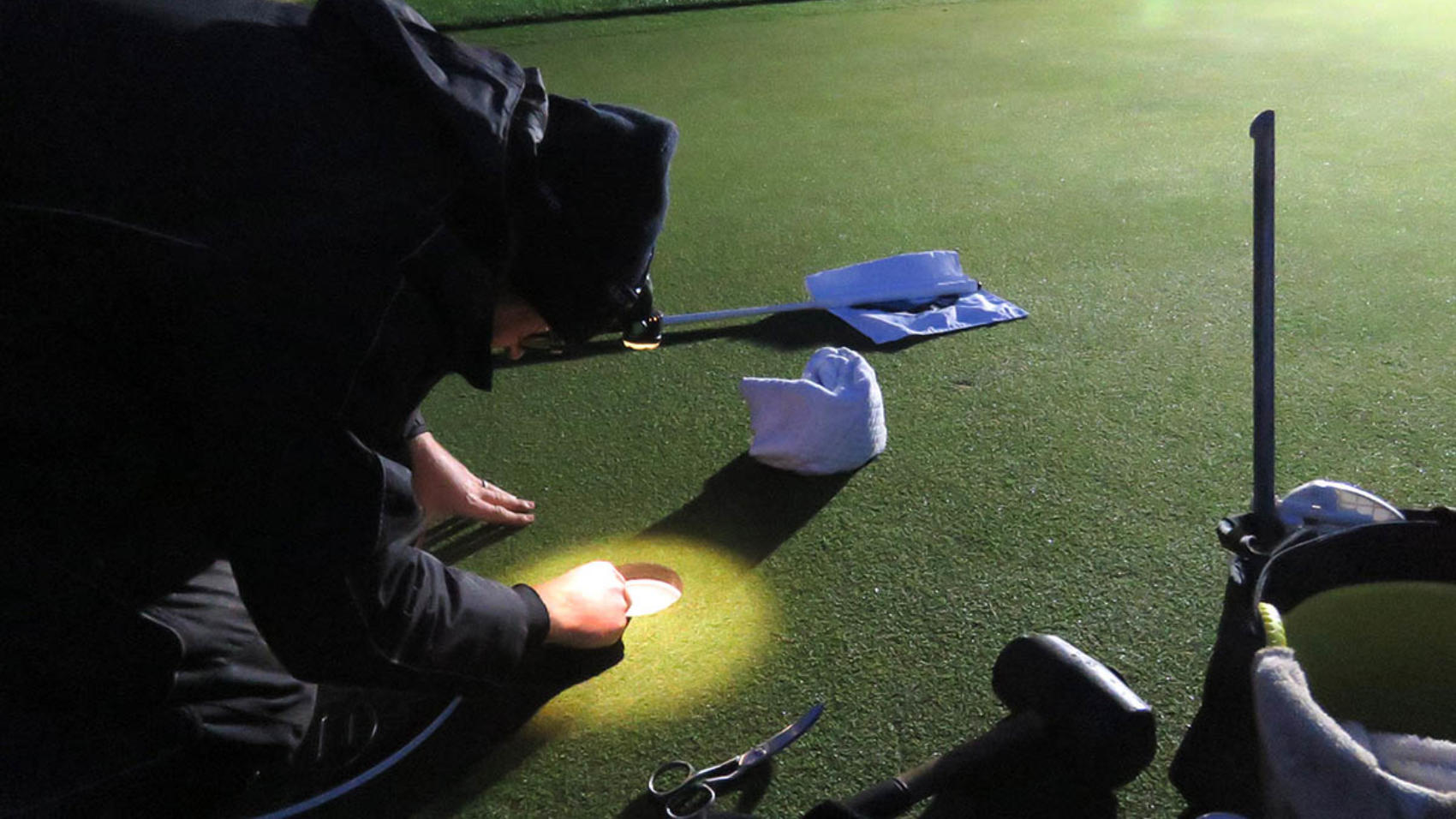
BIGGA: With fewer daylight hours, how are your team adjusting to working in the dark to get the course ready?
Peter: Daylight hours have been the biggest logistical challenge for us. During the May tournament it’s daylight until 9.30pm, whereas in September we’re working under floodlights for the first four holes every morning and the past two evenings we’ve been here until 9.30pm fly-mowing bunkers and spraying greens. Those last two hours have been under floodlights. The pro-am on Wednesday was a shotgun start at 8am, so we were on the course from 4am and for the first 10 holes we were working under floodlights.
On Monday our sprayer technician was out spraying greens under the floodlights and that’s something he’s never done before, with the pressure of knowing that what he’s spraying is going to be seen by millions of people all over the world.
That’s a big thing for the guys to get used to. Working under floodlights is great, but if you haven’t got daylight then you can’t really see the detail. So, we mobilise people to go back to double check everything that we’ve done going through to make sure we’ve not missed anything.
BIGGA: With 4am starts, what time are the team finishing their morning preparation?
Peter: When we’re setting up for the tournament, we don’t just want the greens guys to go and get done. We want to hold them back as long as possible so the time from the last green mowed to the last golfer playing it is as small as possible. If the first golf is at 7am, we anticipate their finishing time is at 11am, so we want to be mowing the green at 10.30am. Ideally, we want to be clearing the 18th green just as they get to 17.
If we finish mowing the 18thgreen at 7am, in May the last golf wouldn’t be through until 9pm. That’s 14 hours difference between fresh cut and last golfer going through. We want to minimise that time to give all the golfers the most consistent surface over the day.
The only pinch point on the golf course is 11 and 6, so as long as we’re through 11 before they reach 6, we can then hang back until they’re through 9 and we can then mow 12, 13, 14 and 15. We’ll then hang back again and then do the final three.
We take our time, go nice and steady, check everything’s good and mobilise people as we need to. My role this week is to choreograph people and make sure they go where they need to go.
BIGGA: What happens on a tournament morning to get the 18thgreen ready for play?
Peter: A good thing is the team will be mowing that green in front of crowds, which is a nice little buzz for them. We’ll send a couple of guys to clear off any debris and switch off any worm casts around the periphery. Then the greens mowers will come in, they’ll mow a single cut at 3mm, then wait. We’ll stimp the green to see what speed it’s at. If we then aren’t at the number we want to get to, we’ll cut again. If we are, we’ll move them on to the next green and tell them to stand by. We’ll then hole change, paint the cup and then everything’s put to bed and the green’s ready to play.
We aren’t rolling this year in the morning because we’re finding there’s a little puffiness and moisture in the surface. We’re only rolling in the evening because the greens have dried out through the day.

BIGGA: What consistency can you achieve across all 18 holes?
Peter: We had one rogue green today, which was the 9th, it was at 11ft 4in. Other than that, all the other greens were within five inches of each other. We’re looking for 12 feet this week, as dictated by the European Tour.
BIGGA: How have you been using the Sub-Air system under the greens this week?
We’ve been using it in vacuum mode through the evenings to try and dry everything down and we’re using it in pressure mode through the days, just at two to three hours at a time. That helps with air circulation in the rootzone and means we can purge some of the bad gas out of there to keep the plants as healthy as possible. If you push fresh air into the rootzone then you push the bad gases out the top. We’re able to aerate into the bottom of the rootzone without having to push holes in the surface.
BIGGA: You mentioned spraying, what are you using to combat turf diseases?
Peter: We’re on creeping bentgrass greens and we’ve got fescue and bents in our approaches. Particularly on the greens in a newer rootzone, my biggest fear is take-all patch, so we spray monthly preventative for that. We rotate the chemistries, mixed with wetting agents and seaweeds, as well as using manganese sulphates and copper products to bring our manganese levels up, to help control take-all. There’s a lot of stuff going on in the background with that.
We sprayed fungicide for fusarium control at the start of September, but purely as a preventative.
BIGGA: One of the visual aspects of the BMW PGA is the rhododendrons in flower, but that won’t be the case this year. What are you hoping will replace them to make the course stand out on television?
Peter: We were hoping our heather would hold on for another couple of weeks, but some low night time temperatures just took the edge off them a little bit. In the sunshine you can still pick out some colour from the heather, but the focus is the going to be the golf course this week, and that’s how we like it.
BIGGA: What’s the greenkeeping team consist of during the event?
Peter: We have 22 guys on the West Course regularly. For the first time we’ve had guys from the East and the Edinburgh come over and they’ve integrated into the team full-time. We’ve then got 24 volunteers, including 20 from BIGGA, plus we’ve got a casual staff who are on hand to help, which takes us up to a total of 60 for set up of the course.
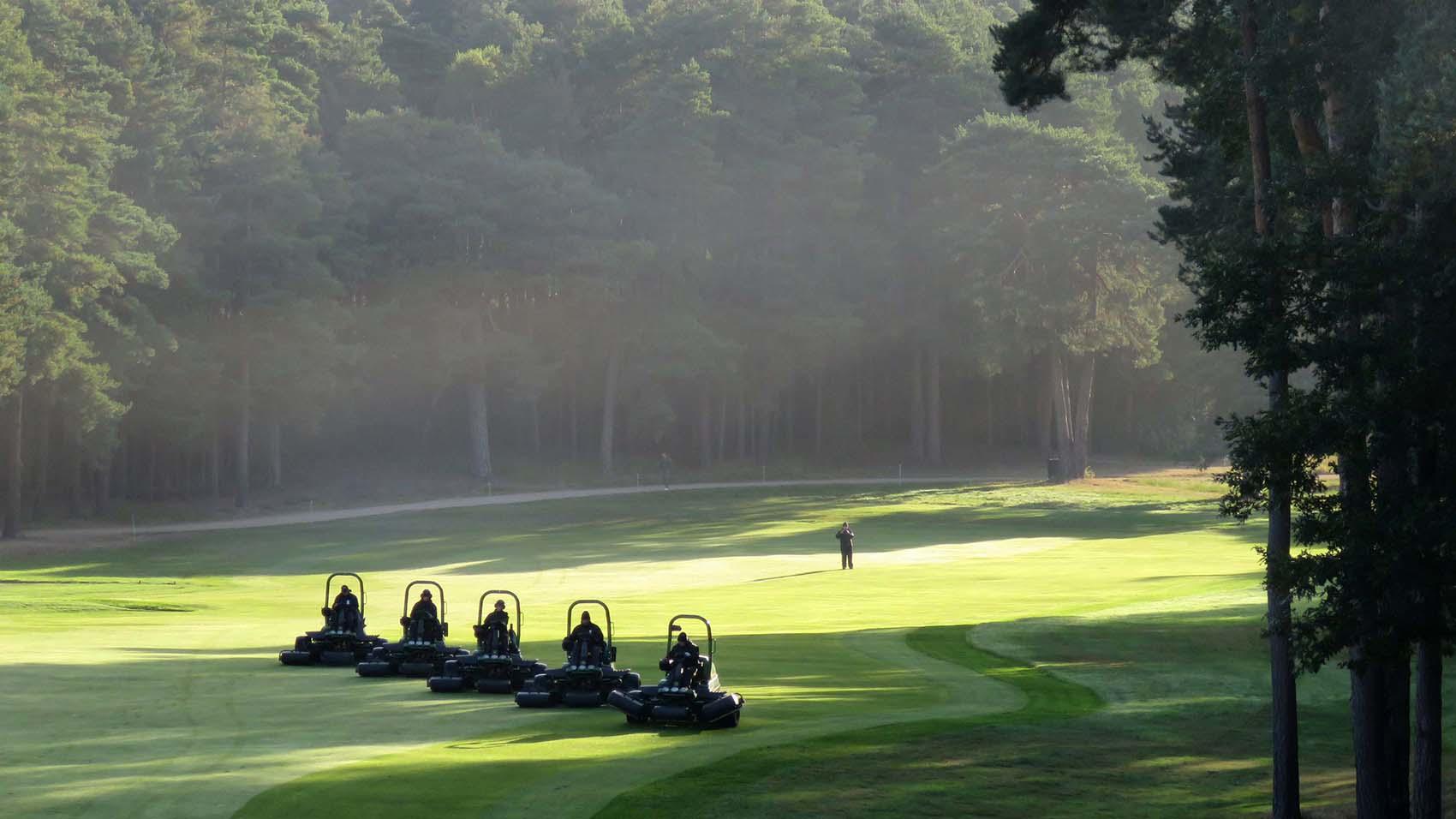
BIGGA: How do you find that increase as a staff, from a personal point of view?
Peter: It’s good. We can get a lot done in a short amount of time. They guys who are here to volunteer are all very highly-skilled guys and they’ve usually been here before so we know we can give them important jobs to do and give them the best volunteer experience that we can. They’ll integrate into the team, a variation in jobs and even putting them under pressure and putting them on things they’ve never been on before, such as fairway mowers. We try and create an experience from a volunteer perspective, as well as giving our full-timers the tools they need to be able to do it.
It’s been very long hours, but everyone in the team chipped in. I said to the guys this morning that it really does sum up what tournament golf is all about. Everyone got involved, everyone loved it, everyone got a buzz out of it and it really did bring the whole team together.
BIGGA: How do you celebrate at the end of the weekend?
Peter: We have our picture taken with the winner on the 18thgreen and then the guys will go down the tented village. A lot of the team bring their family, because it’s not just about the guys themselves but also the people who have supported them to get to that point.
From the Isle of Man TT to the BMW PGA, meet the head greenkeeper in charge of Wentworth’s West Course
Meet Peter Moore, head greenkeeper of Wentworth's West Course
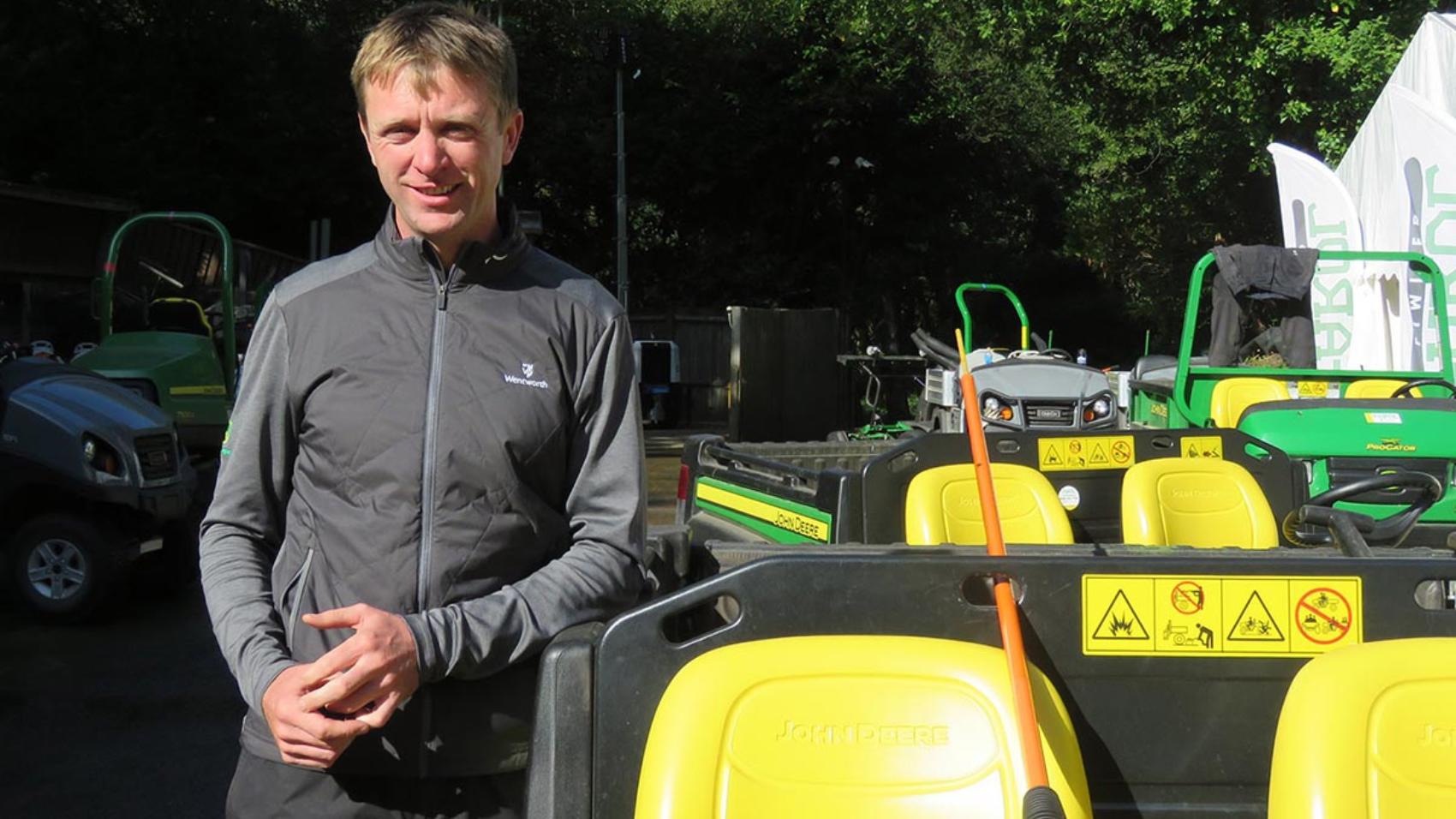
What do the Manx word for ‘turnip’, a lucky number 45 and the BMW PGA Championship have in common?
The answer is Peter Moore, head greenkeeper on Wentworth’s famous West Course and ahead of the event we sat down with Peter to find out a little more about him.
BIGGA: Yours may be a name that people haven’t heard before. Tell us a little about yourself and your history.
Peter: I’ve been greenkeeping since 2003, where I started off at a small course in the Isle of Man, where I grew up. From there I went out on the Ohio State Program to Washington DC at Robert Trent Jones Golf Club. I spent two summers there and then in the winter of 2007 I moved to Tiberon down in Naples, Florida. From there it was back to the UK and I spent a summer in Loch Lomond in 2009. Then since 2010 I’ve been here at Wentworth.
I primarily look after the West Course. There are separate greenkeepers for the East and Edinburgh and on a day-to-day basis we report to Dan Clarke, who’s the courses manager and then Kenny Mackay is the director of golf and grounds.
BIGGA: There’s a large variety of courses there, from the tropics in Florida to one of the wettest places in the UK at Loch Lomond. It’s a wide range of experience.
Peter: I’ve been pretty luck to see some of the things I’ve seen, I’ve worked with warm and cool season grasses, primarily at high end properties, so it’s good to have a comparison between the likes of Loch Lomond and Wentworth. It’s interesting to see how different people run tournaments and now, being in the position I’m in, I’m able to call on those experiences and implement them here.
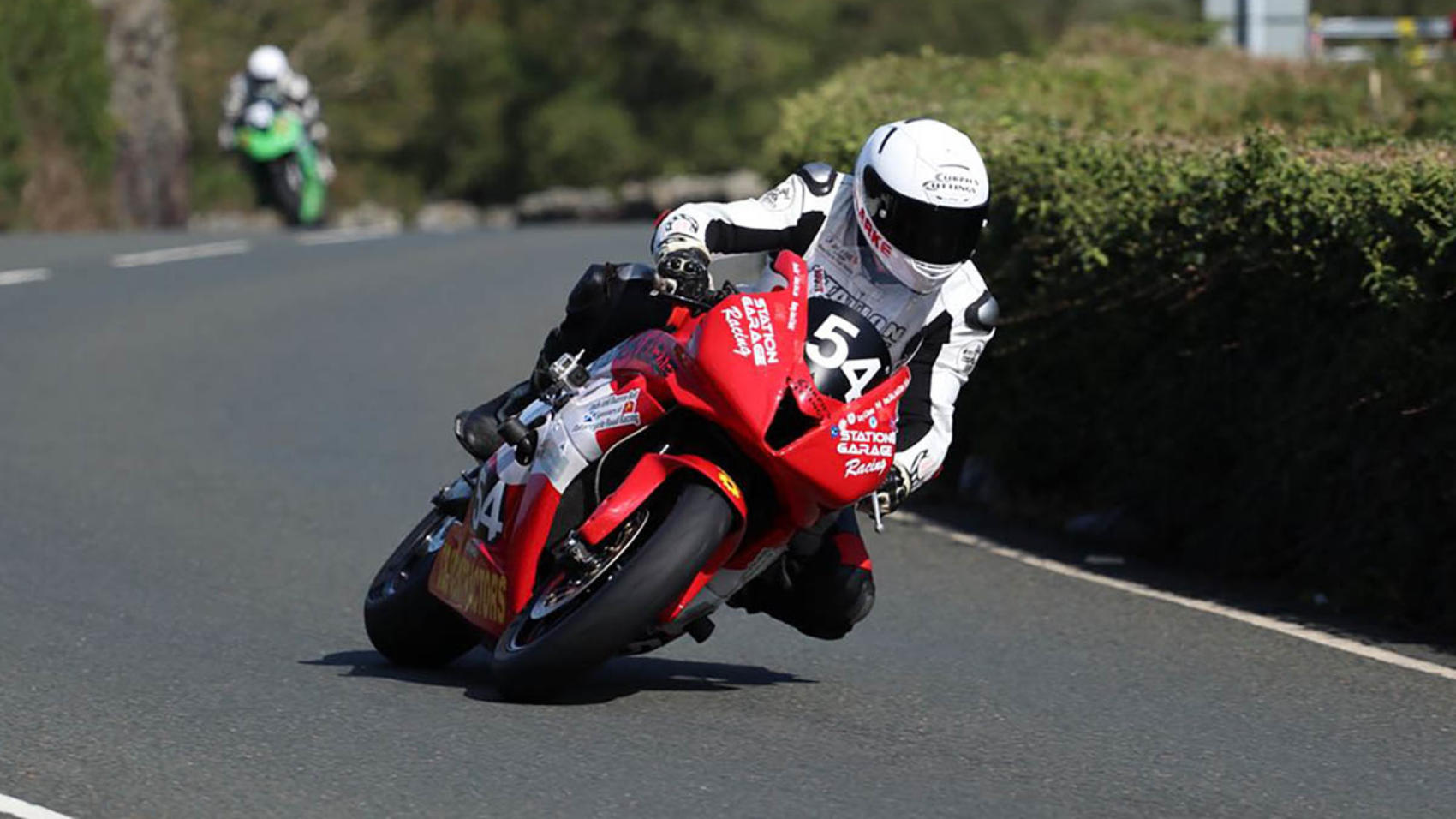
BIGGA: It’s obviously a high-pressure job. What do you do to unwind?
Peter: I race motorbikes. I’ve done the Isle of Man TT three times and raced all over the UK and in Belgium. I’ve won a few races and finished top 10 in the Manx Grand Prix.
BIGGA: There’s a big contrast there between the noise and excitement of motorbike racing and golf greenkeeping. Is one a release from the other, which way around is it?
Peter: Funnily enough, when you’re racing through villages on the Isle of Man at 150mph, you don’t generally think about whether you’ve got fusarium on your 9thgreen.
Everyone within this industry is passionate, you can see that and I work hard at what I do, but at some point, you need a release and for me that’s racing my bike.
I think it’s very important that people have something to do outside of work. This week is very intense, it’s very focused, but I’m looking forward to going out on my bike when it’s all done. That’s what keeps you focused at work because you can unwind and come back fresher.
BIGGA: How can we spot you out on the racetrack?
Peter: I ride with number 45. The first bike I bought had 45 on it and I had loads of success in my first year so I thought I’d keep that number.
BIGGA: Motorbike racers always have nicknames, what’s yours?
Peter: It’s a family nickname from the Isle of Man, the family nickname is ‘Moot’. In Manx slang, a moot is a word for a turnip. As the story goes, my dad and my uncle were called Moot, because they had heads shaped like turnips. So, my race team is called Moot 45.
Tags
Author

Karl Hansell
Karl has been head of communications for BIGGA since March 2016. His duties include editing the monthly Greenkeeper International magazine, in addition to other communications activities for the association.
